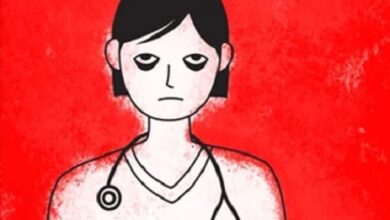8 Types of sadness characteristics possible causes and symptoms
Sadness
Whether for one reason or another, each of us has been sad from time to time . We may have suffered a loss, an interruption, that we received bad news, that we had a fight with someone we care about, that we failed to reach a goal, or simply that someone else’s discomfort removes us internally. In this article we will impart you different 8 Types of sadness.
We may not even know exactly why. But, in each and every one of these cases, it is common to appear a feeling of suffering, pain, frustration, emptiness and inner cold that can change the way we see situations, the world and ourselves, usually with a negative vision.
Sadness, like its counterpart of joy, is a universal emotion and is shared by all humans and other animals. But although the basic emotion is one, the truth is that we often talk about different types of sadness, depending on aspects such as what it is due to or whether it is consistent or useful in relation to this origin .
And it is about these different types of sadness that we will talk throughout this article.
Sadness: what are we doing?
Sadness is one of the so-called basic emotions, along with joy, surprise, fear, surprise, anger and disgust. It is, as we commented, a universal emotion shared by all humanity, regardless of their culture, race or way of life, although it can be expressed in different ways.
It arises as a partly psychic and partly physiological reaction to some kind of event , which may be external or internal. That is, it may seem derived from external events or stimuli (or their absence) or from the existence of concrete thoughts that are aversive to us and about which we consider that we cannot or that we have few options to do something.
Symptoms
It is generally defined as a feeling of discomfort, fatigue and low energy that usually appears alongside a perception of emptiness at the chest or intestinal level, a decrease in self-esteem and a tendency towards isolation and introspection. It is common for there to be some motor slowdown and lower than usual muscle tone. It also tends to go hand in hand with the rumination around what was able to generate its appearance, in addition to a decrease in the attention capacity for the rest of the environment.
Sadness is a highly aversive emotion: most people do not like to be sad, as it usually implies suffering and psychological and / or physical suffering . However, there are also people who experience a tendency or seek states of sadness, due to lack of desire or fear of changing the situations that generate it or due to the existence of secondary benefits.
However, and despite the fact that, in general, we all try to avoid situations that generate this emotion, the fact that we can feel sad (as long as it does not reach pathological levels) is much more beneficial than we might think.
Main adaptive functions of sadness
The existence of sadness as something we can all feel and which, in addition to us, has a large number of animals, is not something by chance: sadness has an adaptive function that favors our survival .
Like pain, the perception of sadness can help us to take some kind of action that allows us to get out of the situation that generates the feeling of discomfort : although sadness generally lowers energy, it also facilitates changes in the future. that prevent a return to aversive stimulation. That is, it can motivate us to change.
Another beneficial aspect is that the reduction of generated energy saves physical strength, in addition to promoting reflection and reflection on what happens around us. In this way, sadness provides us with a context in which we can learn about why it appears and become stronger in the future.
It also makes us able to enter a state of introspection and know deep aspects of our being that we would not consider with another state of mind. Feeling unwell also allows us to train our ability to face adversity and, over time, can alter our perception of competence and self-esteem.
Finally, as a general rule, sadness creates empathy and compassion for group members , and expressing sadness can lead the environment to pay attention and care for us. In this sense, it also has a function of protection and group cohesion.
Types of sadness according to their functionality
In general terms , we can identify four main types of sadness , depending on whether its existence is functional or not.
1. Adaptive sadness
We will consider that we are facing an adaptive or functional sadness when the emotion felt corresponds and is justified based on the situation or aspect that generated it . Therefore, it is a sadness that arises in response to an internal or external event and after which our body may need to decrease the activity level and process the information to accept and adapt.
It is, therefore, a healthy sadness and is characterized by the fact that, with time or action, it will begin to diminish and even disappear. The most typical example is the sadness we feel in a moment of mourning.
2. maladaptive sadness
Sadness is, in principle, naturally adaptable. Now, it is possible that in some people and in certain situations the emotion remains continuously, without being able to manage and cause persistent suffering .
This is what happens when an emotion block and its expression occurs. An unresolved duel that is not accepted would lead to a type of maladaptive sadness.
3. pathological sadness
We consider pathological sadness to be the sensation or feeling of sadness, discouragement and lack of interest in the world in which the person shows little ability to react emotionally, but is usually joined by outbursts of crying .
This weather is not congruent with any event or lack thereof, or appears out of proportion to the situation in which it begins. It can lead to isolation or, in extreme cases, to self-destructive behavior. It’s the kind of sadness that can show up in depression or other disorders.
4. instrumental sadness
We consider instrumental sadness for this type of sadness used to achieve, thanks to it, a specific goal . It is a voluntary use of emotion, although it may be partly sincerely felt.
On the other hand, sometimes we can also face a complete simulation.
A philosophical view: types of sadness according to Saint Thomas Aquinas
Sadness is and always has been one of the most basic human emotions, and it has been studied since ancient times . In this sense, historically some authors and researchers have tried to make different classifications regarding the existence of different types of sadness. An example of this was Saint Thomas Aquinas, who departed from his previous research and classifications of authors such as Aristotle to make his own classification in this regard.
Although it may not have scientific validity, this way of cataloging the types of sadness is interesting on the historical and philosophical levels, as it makes us think that, deep down, the different categories it shows, although they are known as different emotions with one another, they have elements in common in the background. Within this classification, we find the following types of sadness.
1. Sadness for one’s own evil
This type of sadness is characterized by appearing based on the suffering that one feels when some type of painful or aversive situation occurs , or because of the deprivation of our needs and desires. He would be connected with deprivation or misery.
2. Compassion
Under the philosophical prism established by this author, compassion can be considered another type of sadness, which in this case refers to the suffering we perceive in others . Observing the suffering of a loved one moves us and can cause us sadness and discomfort.
3. envy
Another kind of sadness can come from observing how others have some kind of good or achieve some goal that we would want for ourselves. Check that others have what we want and cannot generate sadness and suffering , from which envy arises.
4. Discouragement or distress
Sadness and anxiety are often deeply related. In this sense, discouragement or anguish can be considered a type of sadness that is linked to the loss of mobility or motivation to not find anything that satisfies us or allows us to move towards our goals. It also refers to uncertainty and the desire to hold some kind of good or stay on track regarding your goals.
Depression: not just sadness
One of the concepts usually associated with sadness is depression. And it is that, in major depression or during depressive episodes, one of the main and most important symptoms is the existence of a sad mood.
However, it would be wrong to identify depression with sadness, as the former implies, in addition to being sad, a set of symptoms including anhedonia or lack of ability to feel pleasure, sleep problems (insomnia and excessive sleepiness), loss or increase in appetite , hopelessness and passivity, viewing the world, the self and the future in a negative and aversive way, lack of energy, concentration and libido or even suicidal thoughts.


